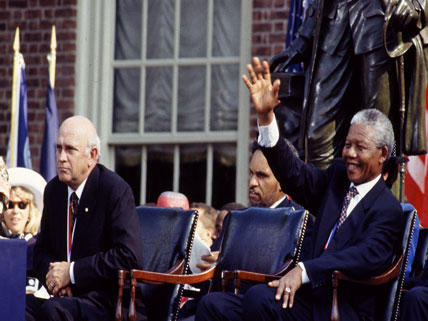 Nelson Mandela (waving) and F. W. de Klerk (left), the last president of apartheid-era South Africa, at award ceremony for the Liberty Medal in Philadelphia, Pennsylvania, July 4, 1993
Nelson Mandela (waving) and F. W. de Klerk (left), the last president of apartheid-era South Africa, at award ceremony for the Liberty Medal in Philadelphia, Pennsylvania, July 4, 1993
Nelson Mandela, the man who led South Africa out of the oppression of apartheid into a new era of democracy, died December 5. Mandela’s impact on his nation was unparalleled, and in the estimation of many he was “the most revered statesman of our time.” Certainly no other African leader has achieved the stature that Mandela did on the global stage—and few from any country have. This fact was evident by the thousands of foreign dignitaries at the funeral services held in his ancestral village of Qunu.
Mandela was born in 1918 and grew up in Mvezo, in the region known as the Transkei. In the 1940s he joined the African National Congress (ANC), which opposed the South African government, then ruled by the country’s white minority. In 1948 South Africa instituted the apartheid system of legalized segregation of the races. Mandela and the ANC pursued nonviolent protests against apartheid until the Sharpeville Massacre, when police opened fire on peaceful protesters, killing 69 of them. He then formed Umkhonto we Sizwe (Spear of the Nation), the military wing of the ANC, and advocated armed resistance. He was arrested, put on trial, and came close to being executed. He spent 27 years in prison, where he endured solitary confinement and inhumane punishments. From prison his influence grew, however; through the “Free Nelson Mandela” campaign, his plight drew international attention. Upon his release in 1990, he entered into negotiations with the South African government to eradicate apartheid.
For his labors to end apartheid peacefully, he and South African president F. W. de Klerk received the Nobel Peace Prize in 1993. The next year Mandela was chosen the first president of South Africa to win office in free and fair democratic elections. As president, he established the Truth and Reconciliation Commission to investigate human rights violations under apartheid by both its supporters and its opponents. Mandela discouraged black South Africans from seeking vengeance against the white minority. After one term as president, he stepped down, but he continued to use his influence to promote peace and social justice both in South Africa and around the world.
Image credit: © Library of Congress Prints & Photographs Division
Related Links
- The Life and Times of Nelson Mandela
The official website of the Nelson Mandela Foundation features vast text, archival, and audiovisual resources on Mandela, South Africa, and the struggle against apartheid.
(Source: NelsonMandela.org; accessed January 3, 2014) - Nelson Mandela
This History website includes a brief biography of Mandela, videos, photo galleries, speeches, and an article defining apartheid.
(Source: History.com; accessed January 3, 2014) - Nelson Mandela, Anti-apartheid Icon and Father of Modern South Africa, Dies
This article recounts highlights of Mandela’s life; includes videos, photo galleries, a timeline, and links to follow-up news stories.
(Source: CNN.com, December 5, 2013) - The Long Walk of Nelson Mandela
Watch the PBS/Frontline special on the life of the South African leader, originally aired in 1999.
(Source: PBS/Frontline; accessed January 3, 2014) - Nelson Mandela, R.I.P.
This eulogy points out the controversies that attended Mandela’s political career while acknowledging that “the good he did, especially as president of the new South Africa, was enormous.”
(Source: National Review, December 6, 2013)




ALLONS-Y
amazing
inspirational
and fantastic